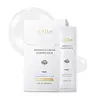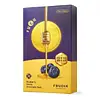What's inside
What's inside
 Key Ingredients
Key Ingredients

 Benefits
Benefits

 Concerns
Concerns

 Ingredients Side-by-side
Ingredients Side-by-side

Water
Skin ConditioningCyclopentasiloxane
EmollientButylene Glycol
HumectantGlycerin
Humectant1,2-Hexanediol
Skin ConditioningHydroxyethyl Urea
HumectantCentella Asiatica Extract
CleansingFicus Carica Fruit Extract
HumectantLaminaria Japonica Extract
Skin ProtectingEclipta Prostrata Leaf Extract
Skin ConditioningCitrus Junos Fruit Extract
Skin ConditioningPersea Gratissima Fruit Extract
EmollientCamellia Sinensis Leaf Extract
AntimicrobialRosmarinus Officinalis Leaf Extract
AntimicrobialChamomilla Recutita Flower Extract
MaskingCentella Asiatica Root Extract
Skin ConditioningCentella Asiatica Leaf Extract
Skin ConditioningGlycyrrhiza Glabra Root Extract
BleachingChenopodium Quinoa Seed Extract
Skin ConditioningPolygonum Cuspidatum Root Extract
AntioxidantScutellaria Baicalensis Root Extract
AstringentTuber Magnatum Extract
Skin ConditioningHippophae Rhamnoides Fruit Oil
Skin ProtectingHydrogenated Lecithin
EmulsifyingSodium Hyaluronate
HumectantOenothera Biennis Oil
EmollientGlycine Soja Oil
EmollientCamellia Japonica Seed Oil
EmollientMacadamia Ternifolia Seed Oil
EmollientPersea Gratissima Oil
Skin ConditioningOlea Europaea Fruit Oil
MaskingBetula Platyphylla Japonica Juice
Skin ConditioningHelianthus Annuus Seed Oil
EmollientDimethicone
EmollientBetaine
HumectantAmmonium Acryloyldimethyltaurate/Vp Copolymer
Acrylates/C10-30 Alkyl Acrylate Crosspolymer
Emulsion StabilisingTromethamine
BufferingAdenosine
Skin ConditioningPolyacrylate-13
Disodium EDTA
Hydroxyethyl Acrylate/Sodium Acryloyldimethyl Taurate Copolymer
Emulsion StabilisingPolyisobutene
Xanthan Gum
EmulsifyingFructooligosaccharides
HumectantBeta-Glucan
Skin ConditioningSorbitan Isostearate
EmulsifyingHydrolyzed Hyaluronic Acid
HumectantCeramide NP
Skin ConditioningPanthenol
Skin ConditioningHydrolyzed Sodium Hyaluronate
Skin ConditioningMaltodextrin
AbsorbentFructan
Skin ConditioningMadecassoside
AntioxidantMadecassic Acid
Skin ConditioningSodium Acetylated Hyaluronate
HumectantSodium Hyaluronate Crosspolymer
HumectantAsiaticoside
AntioxidantAsiatic Acid
Skin ConditioningTocopherol
AntioxidantPotassium Hyaluronate
Skin ConditioningHydroxypropyltrimonium Hyaluronate
Hyaluronic Acid
HumectantSaccharomyces Ferment
Skin ConditioningPolysorbate 20
EmulsifyingParfum
MaskingEthylhexylglycerin
Skin ConditioningWater, Cyclopentasiloxane, Butylene Glycol, Glycerin, 1,2-Hexanediol, Hydroxyethyl Urea, Centella Asiatica Extract, Ficus Carica Fruit Extract, Laminaria Japonica Extract, Eclipta Prostrata Leaf Extract, Citrus Junos Fruit Extract, Persea Gratissima Fruit Extract, Camellia Sinensis Leaf Extract, Rosmarinus Officinalis Leaf Extract, Chamomilla Recutita Flower Extract, Centella Asiatica Root Extract, Centella Asiatica Leaf Extract, Glycyrrhiza Glabra Root Extract, Chenopodium Quinoa Seed Extract, Polygonum Cuspidatum Root Extract, Scutellaria Baicalensis Root Extract, Tuber Magnatum Extract, Hippophae Rhamnoides Fruit Oil, Hydrogenated Lecithin, Sodium Hyaluronate, Oenothera Biennis Oil, Glycine Soja Oil, Camellia Japonica Seed Oil, Macadamia Ternifolia Seed Oil, Persea Gratissima Oil, Olea Europaea Fruit Oil, Betula Platyphylla Japonica Juice, Helianthus Annuus Seed Oil, Dimethicone, Betaine, Ammonium Acryloyldimethyltaurate/Vp Copolymer, Acrylates/C10-30 Alkyl Acrylate Crosspolymer, Tromethamine, Adenosine, Polyacrylate-13, Disodium EDTA, Hydroxyethyl Acrylate/Sodium Acryloyldimethyl Taurate Copolymer, Polyisobutene, Xanthan Gum, Fructooligosaccharides, Beta-Glucan, Sorbitan Isostearate, Hydrolyzed Hyaluronic Acid, Ceramide NP, Panthenol, Hydrolyzed Sodium Hyaluronate, Maltodextrin, Fructan, Madecassoside, Madecassic Acid, Sodium Acetylated Hyaluronate, Sodium Hyaluronate Crosspolymer, Asiaticoside, Asiatic Acid, Tocopherol, Potassium Hyaluronate, Hydroxypropyltrimonium Hyaluronate, Hyaluronic Acid, Saccharomyces Ferment, Polysorbate 20, Parfum, Ethylhexylglycerin
Water
Skin ConditioningButylene Glycol
HumectantCetyl Ethylhexanoate
EmollientPentaerythrityl Tetraethylhexanoate
EmollientVaccinium Angustifolium Fruit Extract
Skin ProtectingPolyglyceryl-3 Methylglucose Distearate
EmulsifyingGlyceryl Stearate Se
EmulsifyingGlycerin
HumectantDiisostearyl Malate
EmollientButyrospermum Parkii Butter
Skin ConditioningCetyl Alcohol
EmollientTrehalose
HumectantGlyceryl Caprylate
EmollientBetaine
HumectantCoco-Caprylate/Caprate
EmollientStearyl Alcohol
EmollientTromethamine
BufferingCoptis Japonica Root Extract
Skin ConditioningCarbomer
Emulsion Stabilising1,2-Hexanediol
Skin ConditioningMyristyl Alcohol
EmollientXanthan Gum
EmulsifyingAcrylates/C10-30 Alkyl Acrylate Crosspolymer
Emulsion StabilisingLauryl Alcohol
EmollientHydrogenated Olive Oil Unsaponifiables
EmollientDisodium EDTA
Hyaluronic Acid
HumectantSodium Hyaluronate
HumectantPanthenol
Skin ConditioningTheobroma Cacao Extract
Skin ConditioningVitis Vinifera Seed Oil
EmollientPrunus Armeniaca Kernel Oil
MaskingRibes Nigrum Leaf Extract
PerfumingHoney Extract
HumectantSolanum Lycopersicum Seed Oil
EmollientPunica Granatum Seed Oil
EmollientMangifera Indica Seed Oil
EmollientCitrus Paradisi Seed Oil
PerfumingCitric Acid
BufferingTocopherol
AntioxidantChlorphenesin
AntimicrobialWater, Butylene Glycol, Cetyl Ethylhexanoate, Pentaerythrityl Tetraethylhexanoate, Vaccinium Angustifolium Fruit Extract, Polyglyceryl-3 Methylglucose Distearate, Glyceryl Stearate Se, Glycerin, Diisostearyl Malate, Butyrospermum Parkii Butter, Cetyl Alcohol, Trehalose, Glyceryl Caprylate, Betaine, Coco-Caprylate/Caprate, Stearyl Alcohol, Tromethamine, Coptis Japonica Root Extract, Carbomer, 1,2-Hexanediol, Myristyl Alcohol, Xanthan Gum, Acrylates/C10-30 Alkyl Acrylate Crosspolymer, Lauryl Alcohol, Hydrogenated Olive Oil Unsaponifiables, Disodium EDTA, Hyaluronic Acid, Sodium Hyaluronate, Panthenol, Theobroma Cacao Extract, Vitis Vinifera Seed Oil, Prunus Armeniaca Kernel Oil, Ribes Nigrum Leaf Extract, Honey Extract, Solanum Lycopersicum Seed Oil, Punica Granatum Seed Oil, Mangifera Indica Seed Oil, Citrus Paradisi Seed Oil, Citric Acid, Tocopherol, Chlorphenesin
Ingredients Explained
These ingredients are found in both products.
Ingredients higher up in an ingredient list are typically present in a larger amount.
1,2-Hexanediol is a synthetic liquid and another multi-functional powerhouse.
It is a:
- Humectant, drawing moisture into the skin
- Emollient, helping to soften skin
- Solvent, dispersing and stabilizing formulas
- Preservative booster, enhancing the antimicrobial activity of other preservatives
Acrylates/C10-30 Alkyl Acrylate Crosspolymer is a synthetic polymer. It is used to thicken and improve the texture of products. Due to its properties, it can prevent water and oil ingredients from separating.
Betaine is a common humectant (a substance that promotes retention of moisture). It's known to be gentle on the skin and can help balance hydration.
This ingredient is best for improving hydration and soothing irritated skin. Studies also show it helps even out skin tone.
Fun fact: Betaine is naturally created in the skin and body. The kind found within cosmetic products can be either plant-derived or synthetic.
Another name for betaine is trimethylglycine.
Learn more about BetaineButylene Glycol (or BG) is used within cosmetic products for a few different reasons:
Overall, Butylene Glycol is a safe and well-rounded ingredient that works well with other ingredients.
Though this ingredient works well with most skin types, some people with sensitive skin may experience a reaction such as allergic rashes, closed comedones, or itchiness.
Learn more about Butylene GlycolDisodium EDTA plays a role in making products more stable by aiding other preservatives.
It is a chelating agent, meaning it neutralizes metal ions that may be found in a product.
Disodium EDTA is a salt of edetic acid and is found to be safe in cosmetic ingredients.
Learn more about Disodium EDTAGlycerin is already naturally found in your skin. It helps moisturize and protect your skin.
A study from 2016 found glycerin to be more effective as a humectant than AHAs and hyaluronic acid.
As a humectant, it helps the skin stay hydrated by pulling moisture to your skin. The low molecular weight of glycerin allows it to pull moisture into the deeper layers of your skin.
Hydrated skin improves your skin barrier; Your skin barrier helps protect against irritants and bacteria.
Glycerin has also been found to have antimicrobial and antiviral properties. Due to these properties, glycerin is often used in wound and burn treatments.
In cosmetics, glycerin is usually derived from plants such as soybean or palm. However, it can also be sourced from animals, such as tallow or animal fat.
This ingredient is organic, colorless, odorless, and non-toxic.
Glycerin is the name for this ingredient in American English. British English uses Glycerol/Glycerine.
Learn more about GlycerinHyaluronic acid is naturally found in healthy skin. It is a humectant, meaning it draws moisture to your skin.
This ingredient helps hydrate, soothe, and protect the skin.
What makes hyaluronic acid so hydrating? It has the capacity to bind or hold large amounts of water.
Fun fact: It is already naturally found in our bodies, such as the fluids of our eyes and our joints.
Studies find this ingredient to have anti-inflammatory and anti-microbial properties. This can help speed up wound-healing.
Hyaluronic acid can be irritating if the molecule has a low-molecular weight, or if the molecules are small.
One study found low-molecular weight hyaluronic acid to be pro-inflammatory, meaning some people may experience irritation. This is because our bodies use hyaluronic acid in the wound-healing process to signal to our bodies, via irritation, that something needs healing.
The same study found high-molecular weight hyaluronic acid to be anti-inflammatory.
These are some other common types of Hyaluronic Acid:
Learn more about Hyaluronic AcidPanthenol is a common ingredient that helps hydrate and soothe the skin. It is found naturally in our skin and hair.
There are two forms of panthenol: D and L.
D-panthenol is also known as dexpanthenol. Most cosmetics use dexpanthenol or a mixture of D and L-panthenol.
Panthenol is famous due to its ability to go deeper into the skin's layers. Using this ingredient has numerous pros (and no cons):
Like hyaluronic acid, panthenol is a humectant. Humectants are able to bind and hold large amounts of water to keep skin hydrated.
This ingredient works well for wound healing. It works by increasing tissue in the wound and helps close open wounds.
Once oxidized, panthenol converts to pantothenic acid. Panthothenic acid is found in all living cells.
This ingredient is also referred to as pro-vitamin B5.
Learn more about PanthenolSodium Hyaluronate is hyaluronic acid's salt form. It is commonly derived from the sodium salt of hyaluronic acid.
Like hyaluronic acid, it is great at holding water and acts as a humectant. This makes it a great skin hydrating ingredient.
Sodium Hyaluronate is naturally occurring in our bodies and is mostly found in eye fluid and joints.
These are some other common types of Hyaluronic Acid:
Learn more about Sodium HyaluronateTocopherol (also known as Vitamin E) is a common antioxidant used to help protect the skin from free-radicals and strengthen the skin barrier. It's also fat soluble - this means our skin is great at absorbing it.
Vitamin E also helps keep your natural skin lipids healthy. Your lipid skin barrier naturally consists of lipids, ceramides, and fatty acids. Vitamin E offers extra protection for your skin’s lipid barrier, keeping your skin healthy and nourished.
Another benefit is a bit of UV protection. Vitamin E helps reduce the damage caused by UVB rays. (It should not replace your sunscreen). Combining it with Vitamin C can decrease sunburned cells and hyperpigmentation after UV exposure.
You might have noticed Vitamin E + C often paired together. This is because it is great at stabilizing Vitamin C. Using the two together helps increase the effectiveness of both ingredients.
There are often claims that Vitamin E can reduce/prevent scarring, but these claims haven't been confirmed by scientific research.
Learn more about TocopherolTromethamine helps balance the pH and improve the texture of a product. It is synthetically created.
As an emulsifier, Tromethamine prevents oil and water ingredients from separating. This helps stabilize the product and elongate a product's shelf life. Tromethamine also makes a product thicker.
Tromethamine helps balance the pH level of a product. Normal pH level of skin is slightly acidic (~4.75-5.5). The acidity of our skin is maintained by our glands and skin biome. Being slightly acidic allows our skin to create an "acid mantle". This acid mantle is a thin barrier that protects our skin from bacteria and contaminants.
Oral Tromethanmine is an anti-inflammatory drug but plays the role of masking, adding fragrance, and/or balancing pH in skincare.
1,3-Propanediol, 2-amino-2-(hydroxymethyl)-
Learn more about TromethamineWater. It's the most common cosmetic ingredient of all. You'll usually see it at the top of ingredient lists, meaning that it makes up the largest part of the product.
So why is it so popular? Water most often acts as a solvent - this means that it helps dissolve other ingredients into the formulation.
You'll also recognize water as that liquid we all need to stay alive. If you see this, drink a glass of water. Stay hydrated!
Learn more about WaterXanthan gum is used as a stabilizer and thickener within cosmetic products. It helps give products a sticky, thick feeling - preventing them from being too runny.
On the technical side of things, xanthan gum is a polysaccharide - a combination consisting of multiple sugar molecules bonded together.
Xanthan gum is a pretty common and great ingredient. It is a natural, non-toxic, non-irritating ingredient that is also commonly used in food products.
Learn more about Xanthan Gum